Reconsidering the Variscan Basement of Southern Tuscany (Inner Northern Apennines)
Abstract
1. Introduction
2. Geological Outline of the Palaeozoic Units of Tuscany
Variscan Basement in Southern Tuscany: The Risanguigno Formation
3. Materials and Methods
4. Results
4.1. Lithological Characteristics
4.2. Fossiliferous Content
4.2.1. Palynological Content
4.2.2. Conodont Content
4.3. Deformation
5. Discussion
5.1. New Bio-Chronological Framework of the Risanguigno Fm
5.2. Paleoenvironmental Insights
5.3. Stratigraphic Setting
5.4. Deformation Insights
5.5. Paleogeographical Implications
6. Conclusions
Author Contributions
Funding
Institutional Review Board Statement
Informed Consent Statement
Data Availability Statement
Acknowledgments
Conflicts of Interest
References
- Vai, G.B. Basement and early (pre-Alpine) history. In Anatomy of an Orogen: The Apennines and Adjacent Mediterranean Basins; Vai, G.B., Martini, I.P., Eds.; Kluwer Academic Publishers: Dordrecht, The Netherlands, 2001; pp. 121–150. [Google Scholar]
- Bagnoli, G.; Giannelli, G.; Puxeddu, M.; Rau, A.; Tongiorgi, M. A tentative stratigraphic reconstruction of the Tuscan Palaeozoic basement. Mem. Soc. Geol. Ital. 1979, 20, 99–116. [Google Scholar]
- Vai, G.B. Evidence of Silurian in the Apuane Alps (Tuscan, Italy). G. Geol. 1972, 38, 349–379. [Google Scholar]
- Bagnoli, G.; Tongiorgi, M. New Fossiliferous Silurian (Mt. Corchia) and Devonian (Monticiano) Layers in the Tuscan Paleozoic. Mem. Soc. Geol. Ital. 1979, 20, 301–313. [Google Scholar]
- Molli, G.; Brogi, A.; Caggianelli, A.; Capezzuoli, E.; Liotta, D.; Spina, A.; Zibra, I. Late Palaeozoic tectonics in Central Mediterranean: A reappraisal. Swiss J. Geosci. 2020, 113, 1–32. [Google Scholar] [CrossRef]
- Carmignani, L.; Carosi, R.; Di Pisa, A.; Gattiglio, M.; Musumeci, G.; Oggiano, G.; Pertusati, P.C. The Hercynian chian in Sardinia. Geodin. Acta 1994, 7, 31–47. [Google Scholar] [CrossRef]
- Carmignani, L.; Cocozza, T.; Ghezzo, C.; Pertusati, P.C.; Ricci, C.A. Guide-Book to the Excursion on the Paleozoic Basement of Sardinia; IGCP Project n. 5, Newsletter, Special Issue; Pacini Editore: Pisa, Italy, 1986; p. 102. [Google Scholar]
- Conti, P.; Di Pisa, A.; Gattiglio, M.; Meccheri, M. The Pre-Alpine Basement in the Alpi Apuane (Northern Apennines, Italy). In Pre-Mesozoic Geology in the Alps; Von Raumer, J.F., Neubauer, F., Eds.; Springer: Berlin/Heidelberg, Germany, 1993; pp. 609–621. [Google Scholar]
- Pandeli, E.; Gianelli, G.; Puxeddu, M.; Elter, F.M. The Paleozoic basement of the northern Apennines: Stratigraphy, tectono-metamorphic evolution and Alpine hydrothermal processes. Mem. Soc. Geol. Ital. 1994, 48, 627–654. [Google Scholar]
- Gattiglio, M.; Meccheri, M.; Tongiorgi, M. Stratigraphic correlation forms of the Tuscan Palaeozoic basement. Rend. Soc. Geol. Ital. 1989, 12, 247–257. [Google Scholar]
- Elter, F.M.; Pandeli, E. Structural features of the metamorphic Paleozoic-Triassic sequences in deep geothermal drillings of the Monte Amiata area (SE Tuscany, Italy). Boll. Soc. Geol. Ital. 1991, 110, 511–522. [Google Scholar]
- Conti, P.; Gattiglio, M.; Meccheri, M. The overprint of the Alpine tectonometamorphic evolution on the Hercynian orogen: An example from the Apuane Alps (Northern Apennines, Italy). Tectonophysics 1991, 191, 335–346. [Google Scholar] [CrossRef]
- Conti, P.; Carmignani, L.; Massa, G.; Meccheri, M.; Patacca, E.; Scandone, P.; Pieruccioni, D. Note Illustrative della Carta Geologica d’Italia alla Scala 1:50.000—“Foglio 249 Massa Carrara”; Servzio Geologico d’Italia: Roma, Italy, 2019; p. 290. [Google Scholar]
- Rau, A. Il Paleozoico Toscano: Da segmento della catena varisica sud- Europea a margine passivo alpidico peri-adriatico. Mem. Soc. Geol. Ital. 1994, 49, 325–334. [Google Scholar]
- Bagnoli, G.; Giannelli, G.; Puxeddu, M.; Rau, A.; Squarci, P.; Tongiorgi, M. Segnalazione di una potente successione clastica di età probabilmente carbonifera nel basamento della Toscana meridionale. Mem. Soc. Geol. Ital. 1980, 21, 127–136. [Google Scholar]
- Pasini, M. I Fusulinidi della valle del Torrente Farma (Toscana meridionale). Mem. Soc. Geol. Ital. 1980, 20, 323–342. [Google Scholar]
- Cocozza, T.; Decandia, F.A.; Lazzarotto, A.; Pasini, M.; Vai, G.B. The marine Carboniferous sequence in Southern Tuscany: Its bearing for Hercinynian palaeogeography and tectofacies. In Pre-Variscan and Variscan Events in the Alpine-Mediterranean Mountain Belts; Flugel, H.V., Sassi, F.P., Grecula, P., Eds.; Mineralia Slovaca-Monography: Bratislava, Slovakia, 1987; pp. 135–144. [Google Scholar]
- Costantini, A.; Decandia, F.A.; Lazzarotto, A.; Sandrelli, F. L’Unità di Monticiano-Roccastrada fra la Montagnola Senese e il Monte Leoni (Toscana meridionale). Atti Tic. Sci. Terra 1988, 31, 382–420. [Google Scholar]
- Lazzarotto, A.; Aldinucci, M.; Cirilli, S.; Costantini, A.; Decandia, F.A.; Pandeli, E.; Sandrelli, F.; Spina, A. Stratigraphic correlation of the Upper Palaeozoic-Triassic successions in Tuscany, Italy: A review. Boll. Soc. Geol. Ital. 2003, 1, 25–35. [Google Scholar]
- Engelbrecht, H. Carboniferous continental margin deposits in southern Tuscany, Italy: Results from geological mapping of the geotopes Farma Valley and San Antonio Mine Area. Geol. J. 2008, 43, 279–305. [Google Scholar] [CrossRef]
- Musumeci, G.; Mazzarini, F.; Tiepolo, M.; Di Vincenzo, G. U–Pb and 40Ar–39Ar geochronology of Palaeozoic units in the northern Apennines: Determining protolith age and alpine evolution using the Calamita Schist and Ortano Porphyroids. Geol. J. 2011, 46, 288–310. [Google Scholar] [CrossRef]
- Sirevaag, H.; Jacobs, J.; Ksienzyk, A.K.; Rocchi, S.; Paoli, G.; Jørgensen, H.; Košler, J. From Gondwana to Europe: The journey of Elba Island (Italy) as recorded by U–Pb detrital zircon ages of Paleozoic metasedimentary rocks. Gondwana Res. 2016, 38, 273–288. [Google Scholar] [CrossRef]
- Paoli, G.; Stokke, H.H.; Rocchi, S.; Sirevaag, H.; Ksienzyk, A.K.; Jacobs, J.; Košler, J. Basement provenance revealed by U-Pb detrital zircon ages: A tale of African and European heritage in Tuscany, Italy. Lithos 2017, 277, 376–387. [Google Scholar] [CrossRef]
- Aldinucci, M.; Brogi, A.; Spina, A. Middle-Late Permian sporomorphs from the Farma Formation (Monticiano-Roccastrada Ridge, southern Tuscany): New constraints for the tectono-sedimentary history of the Tuscan Domain. Boll. Soc. Geol. Ital. 2008, 127, 581–597. [Google Scholar]
- Spina, A.; Capezzuoli, E.; Brogi, A.; Cirilli, S.; Liotta, D. Middle-late Permian microfloristic evidences in the metamorphic successions of Northern Apennines: Insights for age constraining and palaeogeographic correlations. J. Geol. Soc. 2019, 176, 1262–1272. [Google Scholar] [CrossRef]
- Cassinis, G.; Perotti, C.; Ronchi, A. Permian continental basins in the Southern Alps (Italy) and peri-mediterranean correlations. Int. J. Earth Sci. (Geol. Rundsch.) 2012, 101, 129–157. [Google Scholar] [CrossRef]
- Carmignani, L.; Decandia, F.A.; Disperati, L.; Fantozzi, P.L.; Lazzarotto, A.; Liotta, D.; Meccheri, M. Tertiary extensional tectonics in Tuscany (northern Apennines, Italy). Tectonophysics 1994, 238, 295–315. [Google Scholar] [CrossRef]
- Molli, G. Northern Apennine-Corsica orogenic system: An updated overview. Geol. Soc. Lond. Spec. Publ. 2008, 298, 413–442. [Google Scholar] [CrossRef]
- Vai, G.B. Structure and Stratigraphy: An overview. In Anatomy of an Orogen: The Apennines and Adjacent Mediterranean Basins; Vai, G.B., Martini, I.P., Eds.; Kluwer Academic Publishers: Dordrecht, The Netherlands, 2001; pp. 15–31. [Google Scholar]
- Conti, P.; Cornamusini, G.; Carmignani, L. An outline of the geology of the Northern Apennines (Italy), with geological map at 1:250,000 scale. Ital. J. Geosci. 2020, 139, 149–194. [Google Scholar] [CrossRef]
- Brogi, A.; Capezzuoli, E.; Liotta, D.; Meccheri, M. The Tuscan Nappe structures in the Monte Amiata geothermal area (central Italy): A review. Ital. J. Geosci. 2015, 134, 219–236. [Google Scholar] [CrossRef]
- Conti, P.; Costantini, A.; Decandia, F.A.; Elter, F.M.; Gattiglio, M.; Lazzarotto, A.; Meccheri, M.; Pandeli, E.; Rau, A.; Sandrelli, F.; et al. Structural frame of Tuscan Paleozoic: A review. Boll. Soc. Geol. Ital. 1991, 110, 523–541. [Google Scholar]
- Bortolotti, V.; Fazzuoli, M.; Pandeli, F.; Principi, G.; Babbini, A.; Corti, S. Geology of central and eastern Elba Island, Italy. Ofioliti 2001, 26, 97–150. [Google Scholar]
- Carmignani, L.; Decandia, F.A.; Disperati, L.; Fantozzi, P.L.; Kligfield, R.; Lazzarotto, A.; Liotta, D.; Meccheri, M. Inner Northern Apennines. In Anatomy of an Orogen: The Apennines and Adjacent Mediterranean Basins; Vai, G.B., Martini, I.P., Eds.; Kluwer Academic Publishers: Dordrecht, The Netherlands, 2001; pp. 197–214. [Google Scholar]
- Pandeli, E.; Puxeddu, M. Paleozoic age for the Tuscan upper metamorphic sequences of Elba and its implications for the geology of the Northern Apennines (Italy). Eclogae Geol. Helv. 1990, 83, 123–142. [Google Scholar]
- Pandeli, E.; Decandia, F.A.; Tongiorgi, M. The Paleozoic basement through the 500Ma history of the Northern Apennines. In Proceedings of the 32nd International Geological Congress from PR01 to B15, Pre-Congress B05, Florence, Italy, 20–28 August 2004; Volume 1, pp. 1–36. [Google Scholar]
- Vai, G.B. Tentative correlation of Palaeozoic Rocks, ltalian Peninsula and Islands. Oest. Ak. Wiss. Schr. Erd. Kom. 1978, 3, 313–329. [Google Scholar]
- Pandeli, E.; Puxeddu, M.; Gianelli, G.; Bertini, G.T.; Castellucci, P. Paleozoic sequences crossed by deep drillings in the Monte Amiata geothermal region (Italy). Boll. Soc. Geol. Ital. 1988, 107, 593–606. [Google Scholar]
- Pandeli, E.; Gianelli, G.; Morelli, M. The crystalline units of the middle-upper crust of the Larderello geothermal region (southern Tuscany, Italy): New data for their classification and tectono-metamorphic evolution. Boll. Soc. Geol. Ital. 2005, 3, 139–155. [Google Scholar]
- Franceschelli, M.; Gianelli, G.; Pandeli, E.; Puxeddu, M. Variscan and Apine metamorphic events in the Northern Apennines, Italy: A review. Period. Mineral. Spec. Issue 2004, 2, 43–56. [Google Scholar]
- Batini, F.; Brogi, A.; Lazzarotto, A.; Liotta, D.; Pandeli, E. Geological features of the Larderello–Travale and Mt. Amiata geothermal areas (southern Tuscany, Italy). Episodes 2003, 26, 239–244. [Google Scholar] [CrossRef] [PubMed]
- Tongiorgi, M.; Bagnoli, G. Stratigraphie du socle paleozoic de la bordure continentale de l’Apennin septentrional (Italie centrale). Bull. Soc. Geol. Fr. 1981, 23, 319–323. [Google Scholar] [CrossRef]
- Vai, G.B.; Cocozza, T. Tentative schematic zonation of the Hercynian chain in Italy. Bull. Soc. Géol. Fr. 1986, 8, 95–114. [Google Scholar] [CrossRef]
- Pandeli, E.; Bertini, G.; Castellucci, P. The tectonic wedges complex of the Larderello area (southern Tuscany). Boll. Soc. Geol. Ital. 1991, 110, 621–629. [Google Scholar]
- Pandeli, E. Sedimentary-Tectonic evolution of the Tuscan area (Northern Apennines, Italy) from Late «Autunian» to Carnian. Boll. Soc. Geol. Ital. 2002, 1, 251–262. [Google Scholar]
- Brogi, A. The structure of the Monte Amiata volcano-geothermal area (Northern Apennines, Italy): Neogene-Quaternary compression versus extension. Int. J. Earth Sci. 2008, 97, 677–703. [Google Scholar] [CrossRef]
- Cocozza, T. Il Carbonifero nel Gruppo Monticiano-Roccastrada (Toscana). Ric. Sci. Rend. 1965, 8, 1–38. [Google Scholar]
- Pasini, M. Further paleontological records from the Upper Paleozoic outcrops of the Farma Valley (southern Tuscany). In Report on the Tuscan Paleozoic Basement; Tongiorgi, M., Ed.; CNR Internal Report of the Progetto finalizzato Energetica—Sottoprogetto Energia Geotermica: Pisa, Italy, 1978; pp. 71–75. [Google Scholar]
- Pasini, M. Gli Archaeodiscidi dell’affioramento di Poggio alle pigne nella Valle del Farma (Toscana meridionale). Mem. Soc. Geol. Ital. 1980, 20, 343–346. [Google Scholar]
- Rau, A. Evolution of the Tuscan Domain between the Upper Carboniferous and Middle Triassic: A new hypothesis. Boll. Soc. Geol. Ital. 1990, 109, 231–238. [Google Scholar]
- Rau, A.; Tongiorgi, M. Geologia dei Monti Pisani a Sud-Est della Valle del Guappero. Mem. Soc. Geol. Ital. 1974, 13, 216–280. [Google Scholar]
- Cassinis, G.; Elter, G.; Rau, A.; Tongiorgi, M. Verrucano: A tectofacies of the Alpine-Mediterranean Southern Europe. Mem. Soc. Geol. Ital. 1980, 20, 135–149. [Google Scholar]
- Aldinucci, M.; Gandin, A.; Sandrelli, F. The Mesozoic continental rifting in the Mediterranean area: Insights from the Verrucano tectofacies of southern Tuscany (Northern Apennines, Italy). Int. J. Earth Sci. (Geol. Rundsch.) 2008, 97, 1247–1269. [Google Scholar] [CrossRef]
- Franceschelli, M.; Leoni, L.; Memmi, I.; Puxeddu, M. Regional distribution of Al-silicates and metamorphic zonation in the low—Grade Verrucano metasediments from the Northern Apennines, Italy. J. Metam. Geol. 1986, 4, 309–321. [Google Scholar] [CrossRef]
- Theye, T.; Reinhardt, J.; Goffé, B.; Jolivet, L.; Brunet, C. Ferro and magnesiocarpholite from Mt. Argentario (Italy): First evidence for high-pressure metamorphism of the metasedimentary Verrucano sequence, and its significance for the P-T path reconstruction. Eur. J. Mineral. 1997, 9, 859–873. [Google Scholar] [CrossRef]
- Giorgetti, G.; Goffé, B.; Memmi, I.; Nieto, F. Metamorphic evolution of Verrucano metasediments in northern Apennines: New petrological constraints. Eur. J. Mineral. 1998, 10, 1295–1308. [Google Scholar] [CrossRef]
- Brunet, C.; Monié, P.; Jolivet, L.; Cadet, J.P. Migration of compression and extension in the Tyrrhenian Sea, insights from 40Ar/39Ar ages on micas along a transect from Corsica to Tuscany. Tectonophysics 2000, 321, 127–155. [Google Scholar] [CrossRef]
- Rossetti, F.; Faccenna, C.; Jolivet, L.; Goffé, B.; Funiciello, R. Structural signature and exhumation P–T–t paths of the blueschist units exposed in the interior of the Northern Apennine chain, tectonic implication. Boll. Soc. Geol. Ital. 2002, 1, 829–842. [Google Scholar]
- Liotta, D. D2 asymmetric folds and their vergence meaning in the Montagnola Senese metamorphic rocks (inner northern Apennines, central Italy). J. Struct. Geol. 2002, 24, 1479–1490. [Google Scholar] [CrossRef]
- Montomoli, C.; Carosi, R.; Pertusati, P.C. Tectonic history of the Monti dell’Uccellina range, Southern Tuscany, Italy. Boll. Soc. Geol. Ital. 2009, 128, 515–526. [Google Scholar]
- Brogi, A.; Giorgetti, G. Tectono-metamorphic evolution of the siliciclastic units in the Middle Tuscan Range (inner Northern Apennines): Mg–carpholite bearing quartz veins related to syn-metamorphic syn-orogenic foliation. Tectonophysics 2012, 526–529, 167–184. [Google Scholar] [CrossRef]
- Liotta, D.; Cernobori, L.; Nicolich, R. Restricted rifting and its coexistence with compressional structures: Results from the Crop03 traverse (Northern Apennines, Italy). Terra Nova 1998, 10, 16–20. [Google Scholar] [CrossRef]
- Brogi, A. Kinematics and geometry of Miocene low-angle detachments and exhumation of the metamorphic units in the hinterland of the Northern Apennines (Italy). J. Struct. Geol. 2008, 30, 2–20. [Google Scholar] [CrossRef]
- Aldinucci, M.; Pandeli, E.; Sandrelli, F. Tectono-sedimentary evolution of the Late Palaeozoic-Early Mesozoic metasediments of the Monticiano-Roccastrada Ridge (southern Tuscany, Northern Apennines, Italy). Boll. Soc. Geol. Ital. (Ital. J. Geosci.) 2008, 127, 567–579. [Google Scholar]
- Cocozza, T.; Costantini, A.; Lazzarotto, A.; Sandrelli, F. Continental Permian in Southern Tuscany (Italy). In Report on the Tuscan Paleozoic; Tongiorgi, M., Ed.; Consiglio Nazionale delle Ricerche, Rapporto interno del Sottoprogetto Energia Geotermica, Progetto Finalizzato Energetica: Pisa, Italy, 1978; pp. 35–49. [Google Scholar]
- Pasini, M.; Vai, G.B. Review and updating of the Moscovian to Artinskian marine rocks in peninsula Italy. In Peri-Tethys: Stratigraphic Correlations; Crasquin-Soleau, S., De Wever, P., Eds.; Geodiversitas: Paris, France, 1997; Volume 19, pp. 187–191. [Google Scholar]
- Lazzarotto, A.; Decandia, F.A.; Aqué, R.; Bellagotti, E.; Costantini, A.; Sandrelli, F. Carta Geologica Toscana scala 1:10.000, Foglio 307120. 2005. Available online: http://web.rete.toscana.it/pta/servlet/Scheda?foglio=307 (accessed on 5 December 2020).
- Puxeddu, M.; Raggi, G.; Tongiorgi, M. Descrizione di alcuni sondaggi e osservazioni geologiche nel Paleozoico della zona di Monticiano (Siena). Mem. Soc. Geol. Ital. 1979, 20, 233–242. [Google Scholar]
- Spina, A.; Cirilli, S.; Decandia, F.A.; Lazzarotto, A. Palynological data from the Poggio al Carpino sandstones Fm. (Southern Tuscany, Italy). In Proceedings of the International Congress on «Stratigraphic and Structural Evolution of the Late Carboniferous to Triassic Continental and Marine Successions in Tuscany (Italy). Regional Reports and General Correlation», Siena, Italy, 30 April–7 May 2001; pp. 65–66. [Google Scholar]
- Engelbrecht, H. Deposition of Tempestites in the Eastern Rheic Strait: Evidence from the Upper Palaeozoic of Southern Tuscany (Italy). Facies 2000, 43, 103–122. [Google Scholar] [CrossRef]
- Bagnoli, G. Segnalazione di Conodonti devoniani nel Paleozoico della Maremma senese (Nota preliminare). Atti Soc. Tosc. Sci. Nat. Mem. A 1979, 86, 23–26. [Google Scholar]
- Jäger, H. Palynology of the lower carboniferous (Mississippian) kammquartzite formation in the rhenohercynian zone, Germany. Senckenbergiana Lethaea 2002, 82, 609–637. [Google Scholar] [CrossRef]
- Sullivan, H. Miospores from the Lower Lime- Stone Shales (Tournaisian) of the Forest of Dean Basin, Gloucestershire. Compte Rendu 5-eme Congrés International de Stratigraphie et de Géologie du Carbonifère, Paris (1963); Académie des Sciences: Paris, France, 1964; pp. 1249–1259. [Google Scholar]
- Clayton, G. A Lower Carboniferous miospore assemblage from the Calciferous Sandstone Measures of the Cockburnspath region of eastern Scotland. Pollen Spores 1971, 12, 577–600. [Google Scholar]
- Dolby, G. Spore assemblage from the Devonian-Carboniferous transition measures in South-West Britain and Southern Eire. In Colloque sur la Stratigraphie de Carbonifere; Congres et Colloques, Univ. Liège: Liége, France, 1971; Volume 55, pp. 267–274. [Google Scholar]
- Higgs, K. Upper Devonian and Lower Carboniferous miospore assemblages from Hook Head, County Wexford, Ireland. Micropaleontology 1975, 21, 393–419. [Google Scholar] [CrossRef]
- Clayton, G.; Johnston, I.S.; Smith, D.G. Micropalaeontology of a Courceyan (Carboniferous) borehole section from Ballyvergin, County Clare, Ireland. J. Earth Sci. 1980, 3, 81–100. [Google Scholar]
- Higgs, K.T.; Dreesen, R.; Dusar, M.; Streel, M. Palynostratigraphy of the Tournaisian (Hastarian) rocks in the Namur Synclinorium, West Flanders, Belgium. Rev. Palaeobot. Palynol. 1992, 72, 149–158. [Google Scholar] [CrossRef]
- Clayton, G.; Coquel, R.; Doubinger, J.; Gueinn, K.J.; Loboziak, S.; Owens, B.; Streel, M. Carboniferous miospores of Western Europe: Illustration and zonation. Meded. Rijks Geol. Dienst. 1977, 29, 1–71. [Google Scholar]
- Clayton, G.; Higgs, K.; Keegan, J.B.; Sevastopulo, G.D. Correlation of the palynological zonation of the Dinantian of the British Isles. Palinología 1978, 1, 137–147. [Google Scholar]
- Clayton, G.; Turnau, E. Correlation of the Tournaisian miospore zonation of Poland and the British Isles. Ann. Soc. Geol. Pol. 1990, 60, 45–58. [Google Scholar]
- Higgs, K.T. Taxonomic and systematic study of some Tournaisian (Hastarian) spores from Belgium. Rev. Palaeobot. Palynol. 1996, 93, 269–297. [Google Scholar] [CrossRef]
- Playford, G. Miospores from the Mississippian Horton Group, eastern Canada. Geol. Surv. Can. 1964, 107, 1–47. [Google Scholar]
- Utting, J. Palynology of the Lower Carboniferous Windsor Group and Windsor-Canso boundary beds of Nova Scotia, and their equivalents in Quebec, New Brunswick and Newfoundland. Geol. Surv. Can. 1987, 374, 1–93. [Google Scholar]
- Utting, J. Palynostratigraphic investigation of the Albert Formation (Lower Carboniferous) of New Brunswick, Canada. Palynology 1987, 11, 73–96. [Google Scholar] [CrossRef]
- Utting, J.; Keppie, J.D.; Giles, P.S. Palynology and stratigraphy of the Lower Carboniferous Horton Group, Nova Scotia. Contributions to Canadian Paleontology. Geol. Surv. Can. 1989, 396, 117–143. [Google Scholar]
- Gao Lianda 1984. Carboniferous spore assemblages in China. IX Congrès International de Stratigraphie et de Géologie du Carbonifère (Washington and Champaign-Urbana 1979). Compte Rendu 1984, 2, 103–108. [Google Scholar]
- Clayton, G.; Loboziak, S. Early Carboniferous (Early Viséan-Serpukhovian) Palynomorphs. J. Micropalaeontol. 1985, 4–5. [Google Scholar] [CrossRef]
- Loboziak, S.; Clayton, G. The early Carboniferous palynology and stratigraphy of Northeast Libya. In Subsurface Palynostratigraphy of Northeast Libya; El-Arnauti, A., Owens, B., Thusu, B., Eds.; Garyounis University: Benghazi, Libya, 1989; pp. 129–149. [Google Scholar]
- Attar, A.; Fournier, J.; Candilier, A.M.; Coquel, R. Etude palynologique du Dévonien terminal et du Carbonifère inférieur du Bassin d’Illizi (Fort Polignac) Algérie. Rev. l’Institut Français Pétrole 1980, 35, 585–619. [Google Scholar]
- Coquel, R.; Abdesselam-Rouighi, F. Palynostratigraphical revision of the uppermost Devonian-Lower Carboniferous in the Western Great Erg (Bechar Basin) Algerian Sahara. Rev. Micropaléontologie 2000, 43, 353–364. [Google Scholar] [CrossRef]
- Massa, D.; Coquel, R.; Loboziak, S.; Taugourdeau-Lantz, J. Essai de synthèse stratigraphique et palynologique du Carbonifère en Libye Occidentale. Ann. Soc. Géologique Nord. 1980, 99, 429–442. [Google Scholar]
- Grignani, D.L.; Anzoni, E.; Elatrash, H. Palaeozoic and Mesozoic subsurface palynostratigraphy in Al Kufrah basin, Libya. In The Geology of Libya. Third Symposium on the Geology of Libya; Salem, M.J., Hammuda, O.S., Eliagoubi, B.A., Eds.; Elsevier: Amsterdam, The Netherlands, 1991; pp. 1159–1227. [Google Scholar]
- Tawadros, E.; Rasul, S.M.; Elzaroug, R. Petrography and palynology of quartzites in the Sirte Basin, central Libya. J. Afr. Earth Sci. 2001, 32, 373–390. [Google Scholar] [CrossRef]
- Clayton, G. Carboniferous miospore and pollen assemblages from the Kingdom of Saudi Arabia. Rev. Palaeobot. Palynol. 1995, 89, 115–123. [Google Scholar] [CrossRef]
- Clayton, G.; Owens, B.; Al-Hajri, S.; Filatoff, J. Latest Devonian and Early Carboniferous miospore assemblages from Saudi Arabia. In Stratigraphic Palynology of the Palaeozoic Of Saudi Arabia; Al-Hajri, S., Owens, B., Eds.; Geoarabia Special Publication; Gulf PetroLink: Manama, Bahrain, 2000. [Google Scholar]
- Aria-Nasab, M.; Spina, A.; Cirilli, S.; Daneshian, J. The palynostratigraphy of the Lower Carboniferous (middle Tournaisian–upper Viséan) Shishtu Formation from the Howz-e-Dorah section, southeast Tabas, central Iranian Basin. Palynology 2016, 40, 247–263. [Google Scholar] [CrossRef]
- Higgs, K.T.; Finucane, D.; Tunbridge, I.P. Late Devonian and early Carboniferous microfloras from the Hakkarı Province of southeastern Turkey. Rev. Palaeobot. Palynol. 2002, 118, 141–156. [Google Scholar] [CrossRef]
- Loboziak, S.; Streel, M.; Caputo, M.V.; Melo, J.H.G. Middle Devonian to Lower Carboniferous miospore stratigraphy in the central Parnaíba Basin (Brazil). Ann. Société Géologique Belg. 1992, 115, 215–226. [Google Scholar]
- Loboziak, S.; Streel, M.; Caputo, M.V.; Melo, J.H.G. Middle Devonian to Lower Carboniferous miospores from selected boreholes in Amazonas and Parnaíba Basins (Brazil): Additional data, synthesis, and correlation. Doc. Lab. Géologie Lyon 1993, 125, 277–289. [Google Scholar]
- Loboziak, S.; Melo, J.H.G.; Streel, M. Reassessment of Viséan miospore biostratigraphy in the Amazon Basin, northern Brazil. Rev. Palaeobot. Palynol. 1998, 104, 143–155. [Google Scholar] [CrossRef]
- Melo, J.H.G.; Loboziak, S.; Streel, M. Latest Devonian to early Late Carboniferous biostratigraphy of northern Brazil: An update. Bull. Cent. Rech. Elf Explor.-Prod. 1999, 22, 13–33. [Google Scholar]
- Playford, G.; Dino, R.; Marques-Toigo, M. The upper Paleozoic miospore genus Spelaeotriletes Neves and Owens, 1966, and constituent Gondwanan species. J. South Am. Earth Sci. 2001, 14, 593–608. [Google Scholar] [CrossRef]
- Melo, J.H.G.; Loboziak, S. Devonian-Early Carboniferous miospore biostratigraphy of the Amazon Basin, Northern Brazil. Rev. Palaeobot. Palynol. 2003, 124, 131–202. [Google Scholar] [CrossRef]
- Loboziak, S.; Vachard, D.; Fadli, D.; Streel, M. Datation par miospores et Foraminifères du Tournaisien et du Viséen de l’Oued Zemrine (Massif des Mdakra, Maroc). J. Afr. Earth Sci. 1990, 11, 113–118. [Google Scholar] [CrossRef]
- Owens, B.; Filatoff, J.; Clayton, G.; Al-Hajri, S. Evidence of mid-Carboniferous miospore assemblages from central Saudi Arabia. Stratigraphic Palynology of the Palaeozoic of Saudi Arabia. GeoArabia Spec. Publ. 2000, 1, 154–167. [Google Scholar]
- Bouillin, J.P.; Majesté-Menjoulas, C.; Baudelot, S.; Cygan, C.; Fournier-Vinas, C. Les formations paléozoiques de l’Arc Calabro-Péloritain dans leur cadre structural. Boll. Soc. Geol. Ital. 1987, 106, 683–698. [Google Scholar]
- Randon, C. Siliceous deposits within a carbonate sequence: A significant event. In Carboniferous Conference Cologne. From Platform to Basin. Sept 4–10 2006; Aretz, M., Herbig, H.-G., Eds.; Program and Abstracts; Kölner Forum für Geologie und Paläontologie: Köln, Germany, 2006; Volume 15, p. 106. [Google Scholar]
- Randon, C.; Caridroit, M. Age and origin of Mississippian lydites: Examples from the Pyrénées, southern France. Geol. J. 2008, 43, 261–278. [Google Scholar] [CrossRef]
- Renna, M.R.; Tribuzio, R.; Tiepolo, M. Interaction between basic and acid magmas during the latest stages of the post-collisional Variscan evolution: Clues from the gabbro-granite association of Ota (Corsica-Sardinia batholith). Lithos 2006, 90, 92–110. [Google Scholar] [CrossRef]
- Edel, J.B.; Casini, L.; Oggiano, G.; Rossi, P.; Schulmann, K. Early Permian 90 clockwise rotation of the Maures–Esterel–Corsica–Sardinia block confirmed by new palaeomagnetic data and followed by a Triassic 60 clockwise rotation. Geol. Soc. Lond. Spec. Publ. 2014, 405, 333–361. [Google Scholar] [CrossRef]
- Casini, L.; Cuccuru, S.; Puccini, A.; Oggiano, G.; Rossi, P. Evolution of the Corsica–Sardinia Batholith and late-orogenic shearing of the Variscides. Tectonophysics 2015, 646, 65–78. [Google Scholar] [CrossRef]
- Paquette, J.L.; Ménot, R.-P.; Pin, C.; Orsini, J.B. Episodic and short-lived granitic pulses in a post-collisional setting: Evidence from precise U–Pb zircon dating through a crustal cross-section in Corsica. Chem. Geol. 2003, 198, 1–20. [Google Scholar] [CrossRef]
- Li, X.-H.; Faure, M.; Lin, W. From crustal anatexis to mantle melting in the Variscan orogen of Corsica (France): SIMS U-Pb zircon age constraints. Tectonophysics 2014, 634, 219–230. [Google Scholar] [CrossRef]
- Rossi, P.; Cocherie, A.; Fanninng, C.M. Evidence in Variscan Cosica of a brief and voluminous Late Carboniferous to Early Permian volcanic–plutonic event contemporaneous with a high-temperature/low-pressure metamorphic peak in the lower crust. Bull. Soc. Géol. Fr. 2015, 186, 171–192. [Google Scholar] [CrossRef]
- Neves, R.; Sullivan, H.J. Modification of fossil spore exines associated with the presence of pyrite crystals. Micropaleontology 1964, 10, 443–452. [Google Scholar] [CrossRef]
- Ouyang, S.; Utting, J. Palynology of Upper Permian and Lower Triassic rocks, Meishan, Changxing County, Zhejiang Province, China. Rev. Palaeobot. Palynol. 1990, 66, 65–103. [Google Scholar] [CrossRef]
- Turnau, E. Note on the preservational nature of ornamentation in sphaeromorphs assignable to Tapajonites Sommer & van Boekel, 1963 (Prasinophyta?). J. Micropalaeontology 2000, 19, 159–162. [Google Scholar] [CrossRef]
- Traverse, A. Paleopalynology, 2nd ed.; Springer: Dordrecht, The Netherlands, 2008; p. 813. [Google Scholar] [CrossRef]
- Tyson, R.V. Sedimentary Organic Matter; Organic Facies and Palynofacies, 1st ed.; Chapman and Hall: Davon, UK, 1995; p. 615. [Google Scholar]
- Gursky, H.-J. Pelagic facies of the Early Carboniferous—From Laurasia’s margin to Iberia. In Carboniferous Conference Cologne. From Platform to Basin, Sept 4–10 2006; Aretz, M., Herbig, H.-G., Eds.; Program and Abstracts; Kolner Forum fur Geologie und Palaontologie: Köln, Germany, 2006; Volume 15, p. 35. [Google Scholar]
- Saltzman, M.R.; Groessens, E.; Zhuravlev, A. Carbon cycle models based on extreme changes in δ13C: An example from the Lower Mississippian. Palaeogeogr. Palaeoclimatol. Palaeoecol. 2004, 213, 359–377. [Google Scholar] [CrossRef]
- Cheng, K.; Elrick, M.; Romaniello, S.J. Early Mississipian ocean anoxia triggered organic carbon burial and late Paleozoic cooling: Evidence from uranium isotopes recorded in marina limestone. Geology 2020, 48, 363–367. [Google Scholar] [CrossRef]
- Montañez, I.P.; Poulsen, C.J. The Late Paleozoic Ice Age: An evolving paradigm. Annu. Rev. Earth Planet. Sci. 2013, 41, 629–656. [Google Scholar] [CrossRef]
- Saltzman, M.R.; González, L.A.; Lohmann, K.C. Earliest Carboniferous cooling step triggered by the Antler orogeny? Geology 2000, 28, 347–350. [Google Scholar] [CrossRef]
- Saltzman, M.R. Late Paleozoic ice age: Oceanic gateway or pCO2? Geology 2003, 31, 151–154. [Google Scholar] [CrossRef]
- Buggisch, W.; Joachimski, M.M.; Sevastopulo, G.; Morrow, J.R. Mississippian δ13C carb and conodont apatite δ18O recordsTheir relation to the late Palaeozoic glaciation. Palaeogeogr. Palaeoclimatol. Palaeoecol. 2008, 268, 273–292. [Google Scholar] [CrossRef]
- Liu, J.; Algeo, T.J.; Qie, W.; Saltzman, M.R. Intensified oceanic circulation during early Carboniferous cooling events: Evidence from carbon and nitrogen isotopes. Palaeogeogr. Palaeoclimatol. Palaeoecol. 2018, 531, 108962. [Google Scholar] [CrossRef]
- Maharjan, D.; Jiang, G.; Peng, Y.; Henry, R.A. Paired carbonate–organic carbon and nitrogen isotope variations in Lower Mississippian strata of the southern Great Basin, western United States. Palaeogeogr. Palaeoclimatol. Palaeoecol. 2018, 490, 462–472. [Google Scholar] [CrossRef]
- Pandeli, E. Permo-Triassic siliciclastic sedimentation in the Northern Apennines: New data from the Iano metamorphic inlier (Florence). Mem. Soc. Geol. Ital. 1998, 53, 185–206. [Google Scholar]
- Costantini, A.; Elter, F.M.; Pandeli, E.; Sandrelli, F. Geologia dell’area di Iano (Toscana meridionale, Italia). Boll. Soc. Geol. Ital. 1998, 117, 187–218. [Google Scholar]
- Marini, F.; Pandeli, E.; Tongiorgi, M.; Pecchioni, E.; Orti, L. The Carboniferous-mid Permian successions of the Northern Apennines: New data from the Pisani Mts. inlier (Tuscany, Italy). Ital. J. Geosci. 2020, 139, 212–232. [Google Scholar] [CrossRef]
- Pasini, M. Edmondia scalaris (M’Coy, 1844) e Phestia cf. attenuata (Fleming 1828) nella Formazione Carpineta (Paleozoico superiore della Toscana meridionale). Riv. Ital. Paleont. Stratigr. 1978, 84, 849–864. [Google Scholar]
- Ferraresi, E.; Pasini, M. Some fossil algae from the Carboniferous of the Farma Gorge (southeastern Tuscany, Italy). Palaeopelagos 1996, 6, 31–43. [Google Scholar]
- Von Raumer, J.F.; Stampfli, G.M.; Borel, G.D.; Bussy, F. The organisation of pre-Variscan basement areas at the north-Gondwanan margin. Int. J. Earth Sci. 2002, 91, 35–52. [Google Scholar] [CrossRef]
- Von Raumer, J.F.; Stampfli, G.M.; Bussy, F. Gondwana-derived microcontinents-the constituents of the Variscan and Alpine collisional orogens. Tectonophysics 2003, 365, 7–22. [Google Scholar] [CrossRef]
- Von Raumer, J.F.; Bussy, R.; Schaltegger, U.; Schulz, B.; Stampfli, G.M. Pre-Mesozoic Alpine basements-Their place in the European Paleozoic framework. Geol. Soc. Am. Bull. 2013, 125, 89–108. [Google Scholar] [CrossRef]
- Spiess, R.; Cesare, B.; Mazzoli, C.; Sassi, R.; Sassi, F.P. The cristalline basement of the Adria microplate in the eastern Alps: A review of the paleostructural evolution from Neoproterozoic to Tertiary. Rend. Lincei 2010, 12, 31–50. [Google Scholar] [CrossRef]
- Cassinis, G.; Perotti, C.; Santi, G. Post-Variscan Verrucano-like deposits in Italy, and the onset of the alpine tectono-sedimentary cycle. Earth-Sci. Rev. 2018, 185, 476–497. [Google Scholar] [CrossRef]
- Ballevre, M.; Manzotti, P.; Dal Piaz, G.V. Pre-Alpine (Variscan) Inheritance: A Key for the Location of the Future Valaisan Basin (Western Alps). Tectonics 2018, 737, 86–817. [Google Scholar] [CrossRef]
- Barca, S.; Farci, G.; Forci, A. I depositi sinorogenici ercinici del Sulcis (Sardegna sud-occidentale). Boll. Soc. Geol. Ital. 1998, 117, 407–419. [Google Scholar]
- Carmignani, L.; Conti, P.; Barca, S.; Cerbai, N.; Eltrudis, A.; Funedda, A.; Oggiano, G.; Patta, E.D. Carta Geologica d’Italia alla Scala 1:50.000 “Foglio 549—Muravera”; Servizio Geologico d’Italia: Roma, Italy, 2001. [Google Scholar]
- Carmignani, L.; Oggiano, G.; Barca, S.; Conti, P.; Salvadori, I.; Eltrudis, A.; Funedda, A.; Pasci, S. Geologia della Sardegna: Note Illustrative della Carta Geologica della Sardegna in Scala 1:200.000, Memorie Descrittive della Carta Geologica d’Italia; Servizio Geologico d’Italia: Roma, Italy, 2001; Volume 60, p. 283. [Google Scholar]
- Funedda, A. Foreland- and hinterland-verging structures in fold-and- thrust belt: An example from the Variscan foreland of Sardinia. Int. J. Earth Sci. 2009, 98, 1625–1642. [Google Scholar] [CrossRef]
- Rau, A. Lineamenti profondi nel basamento pre-Triassico della Toscana continentale (Italia). Studi Geol. Camerti 1991, 1, 141–148. [Google Scholar]
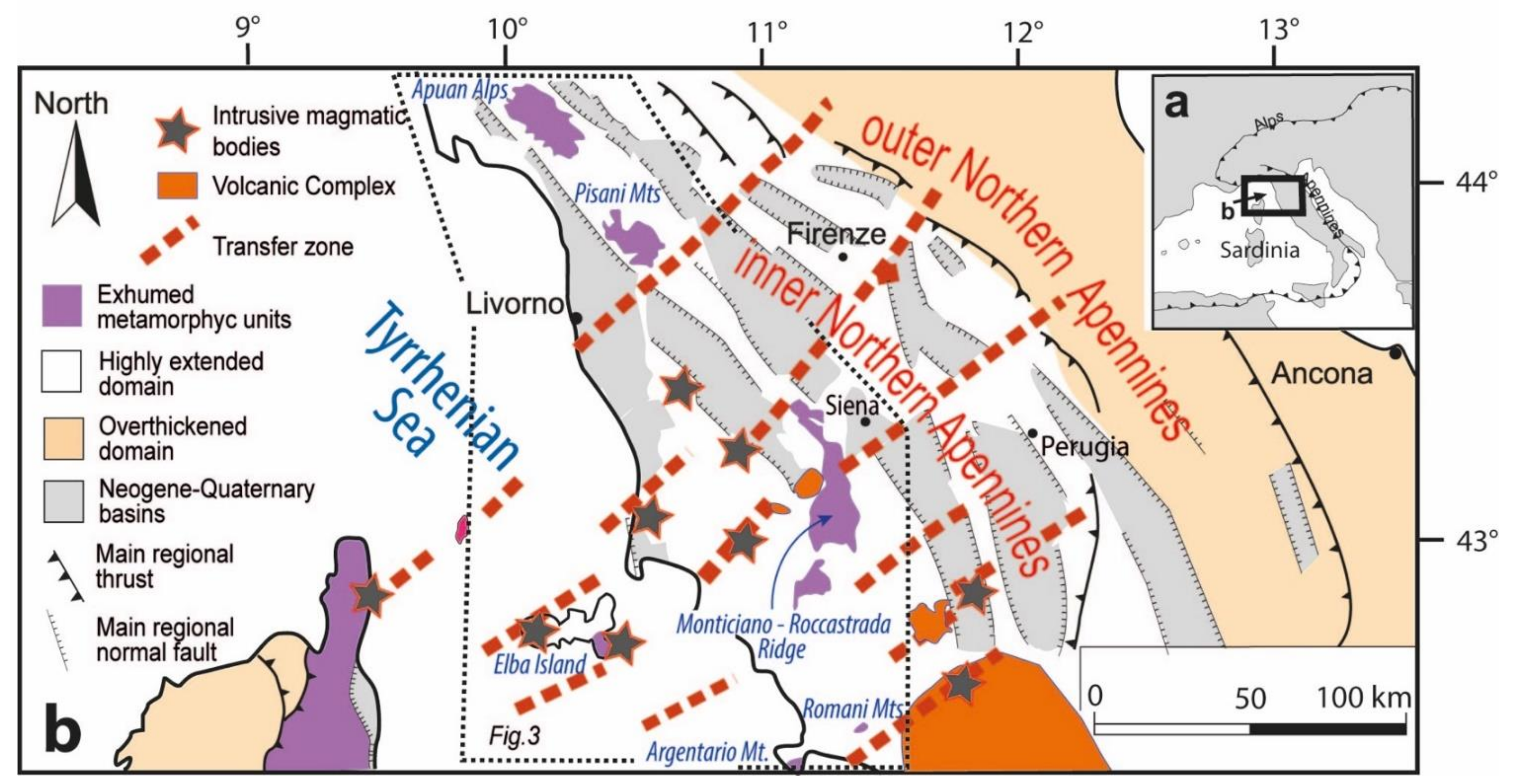
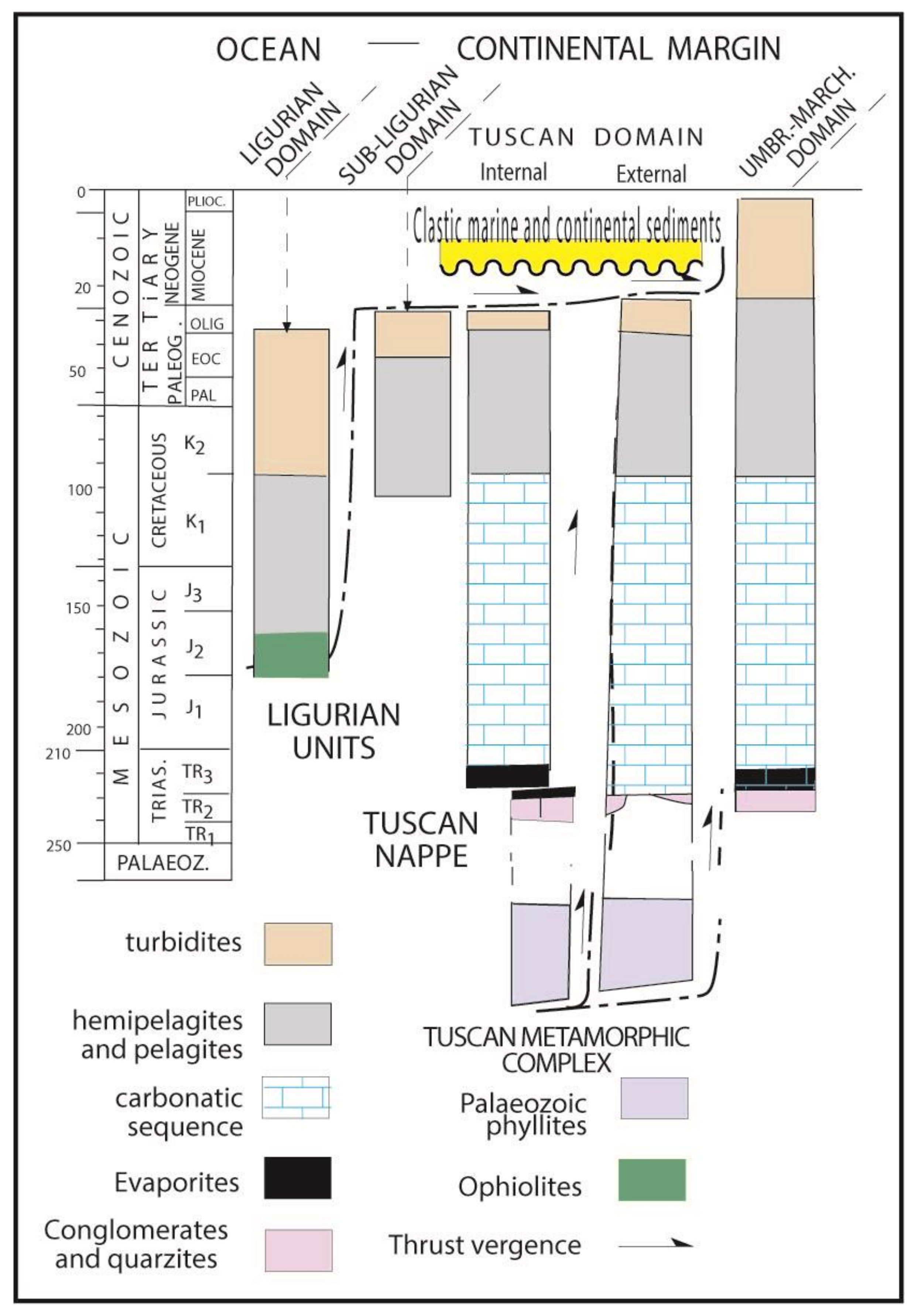
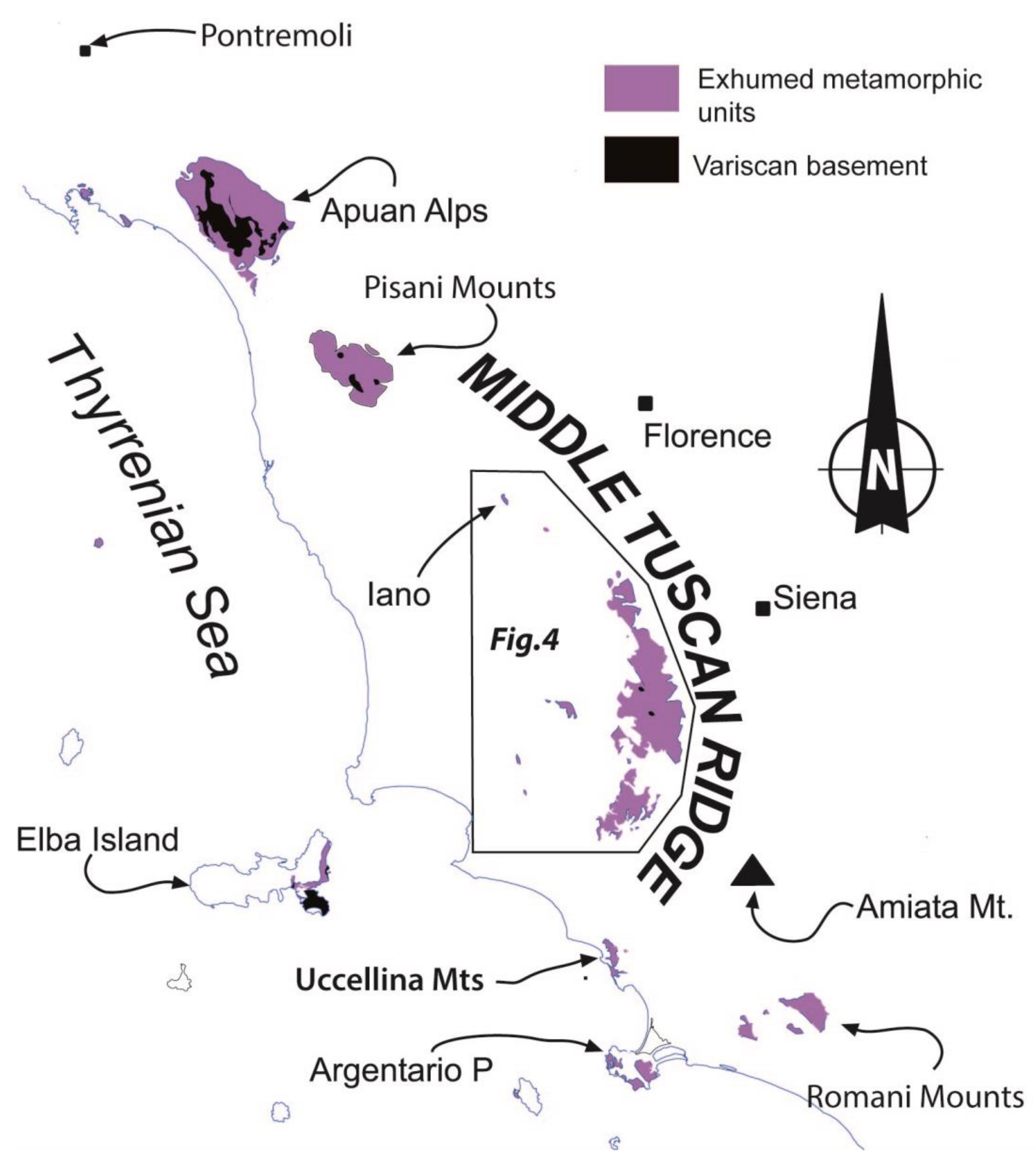

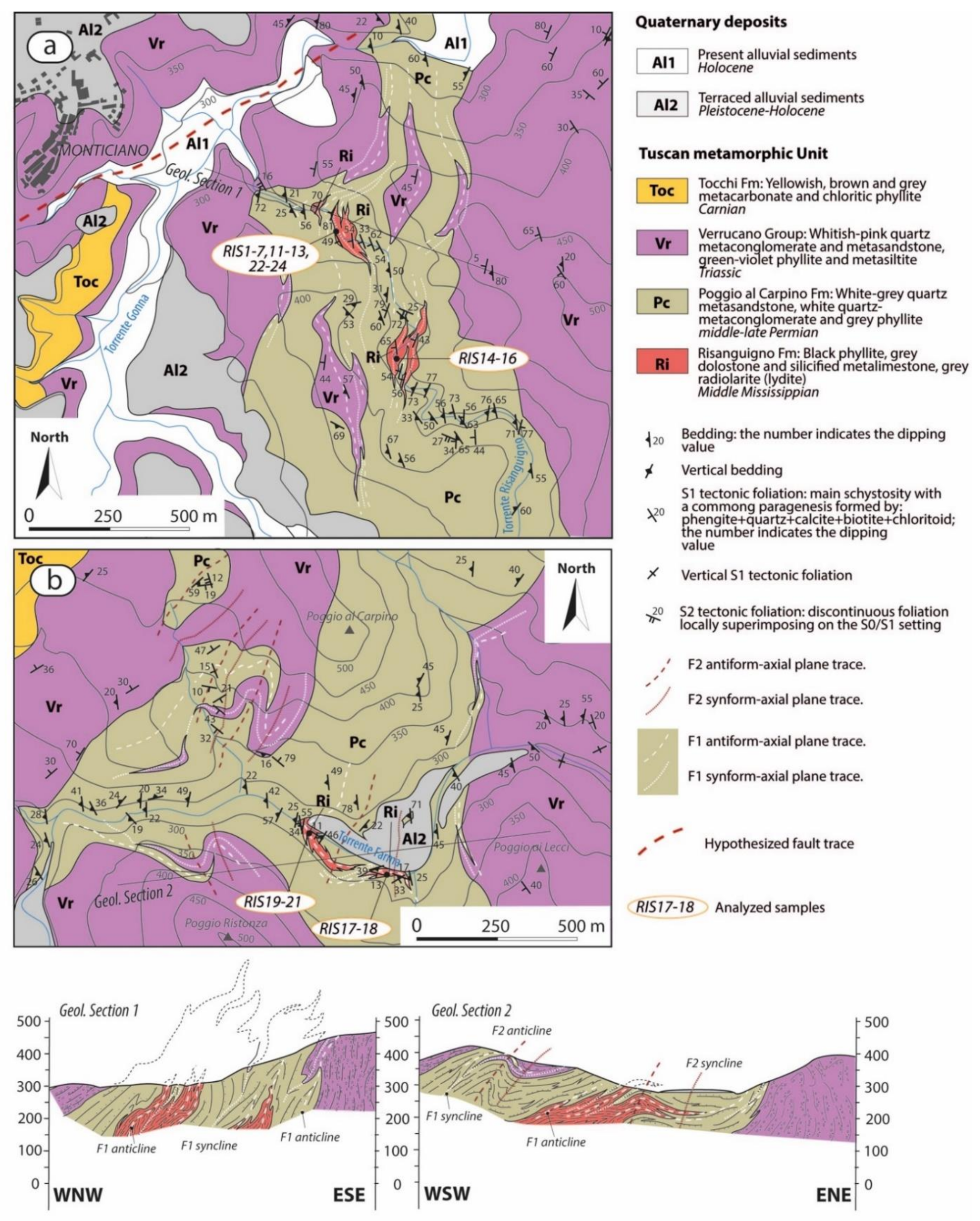
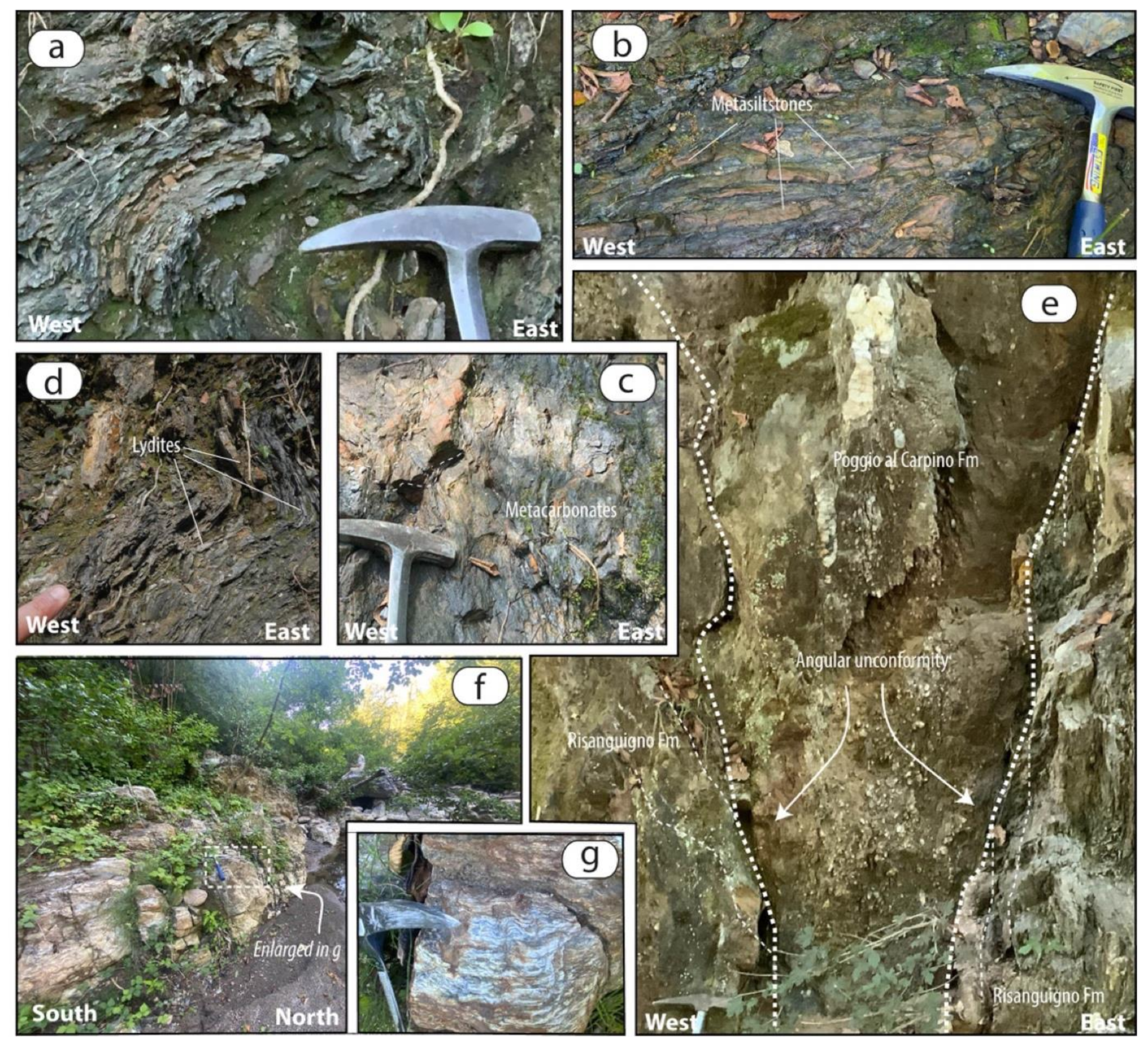
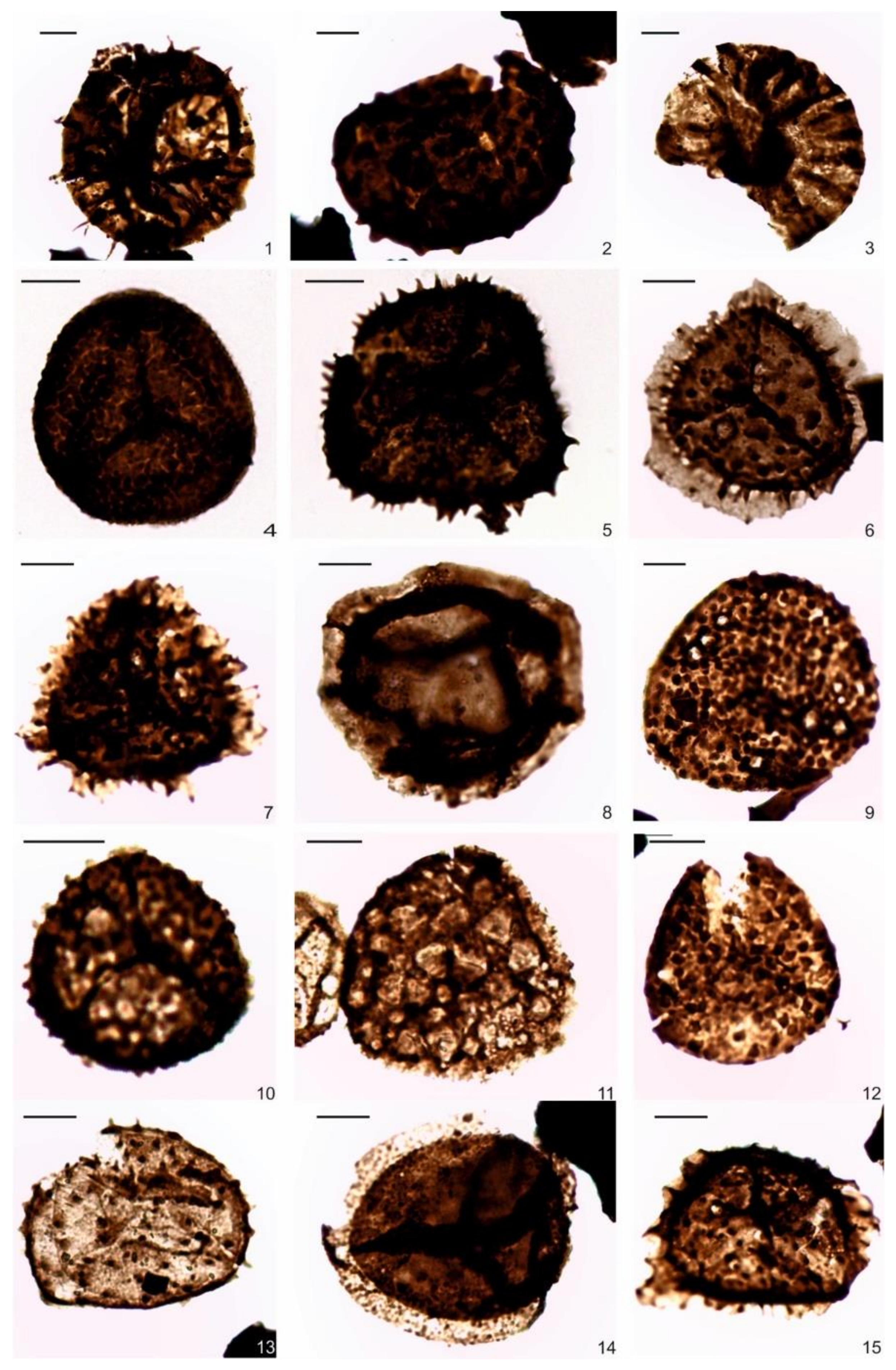
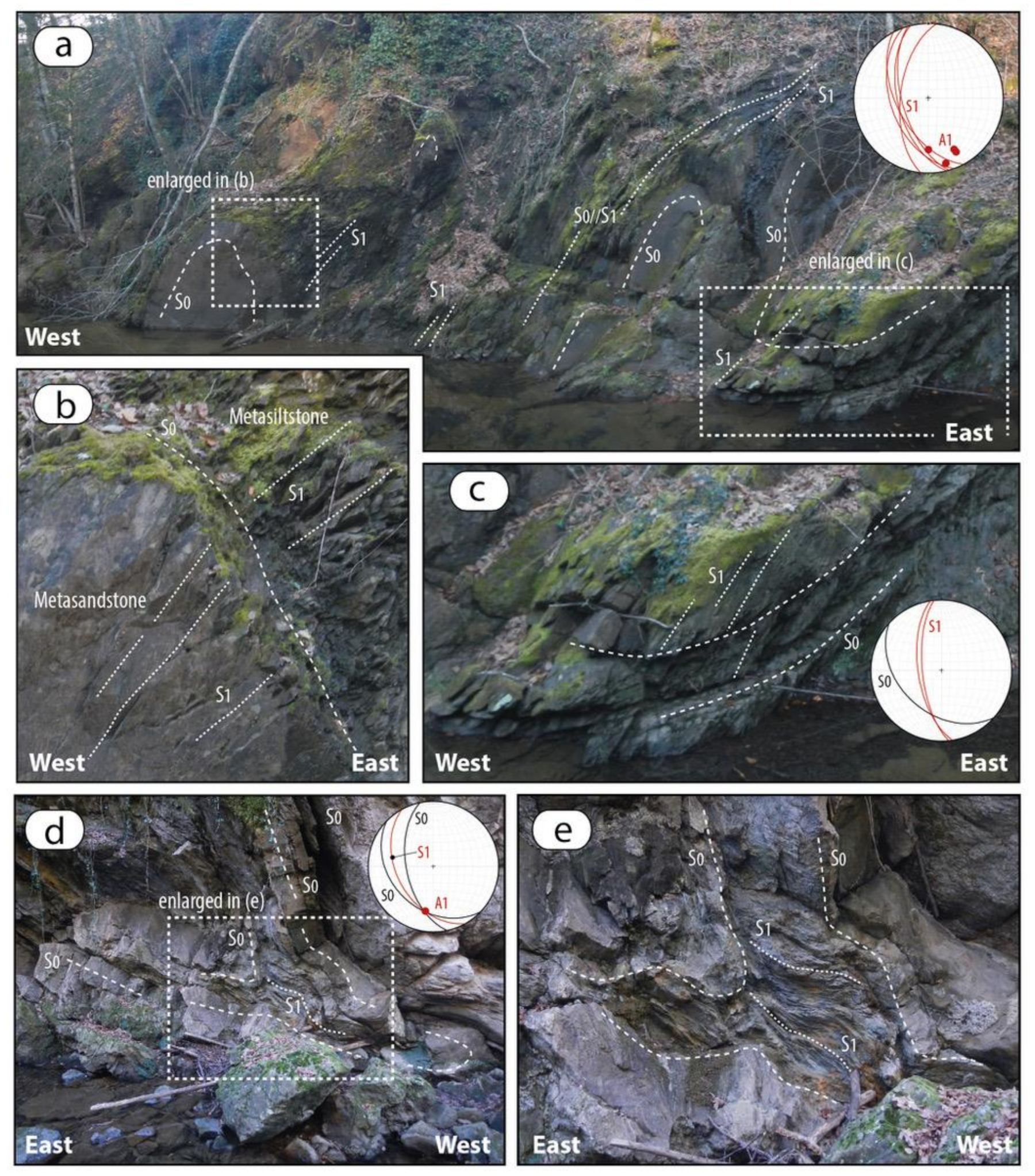

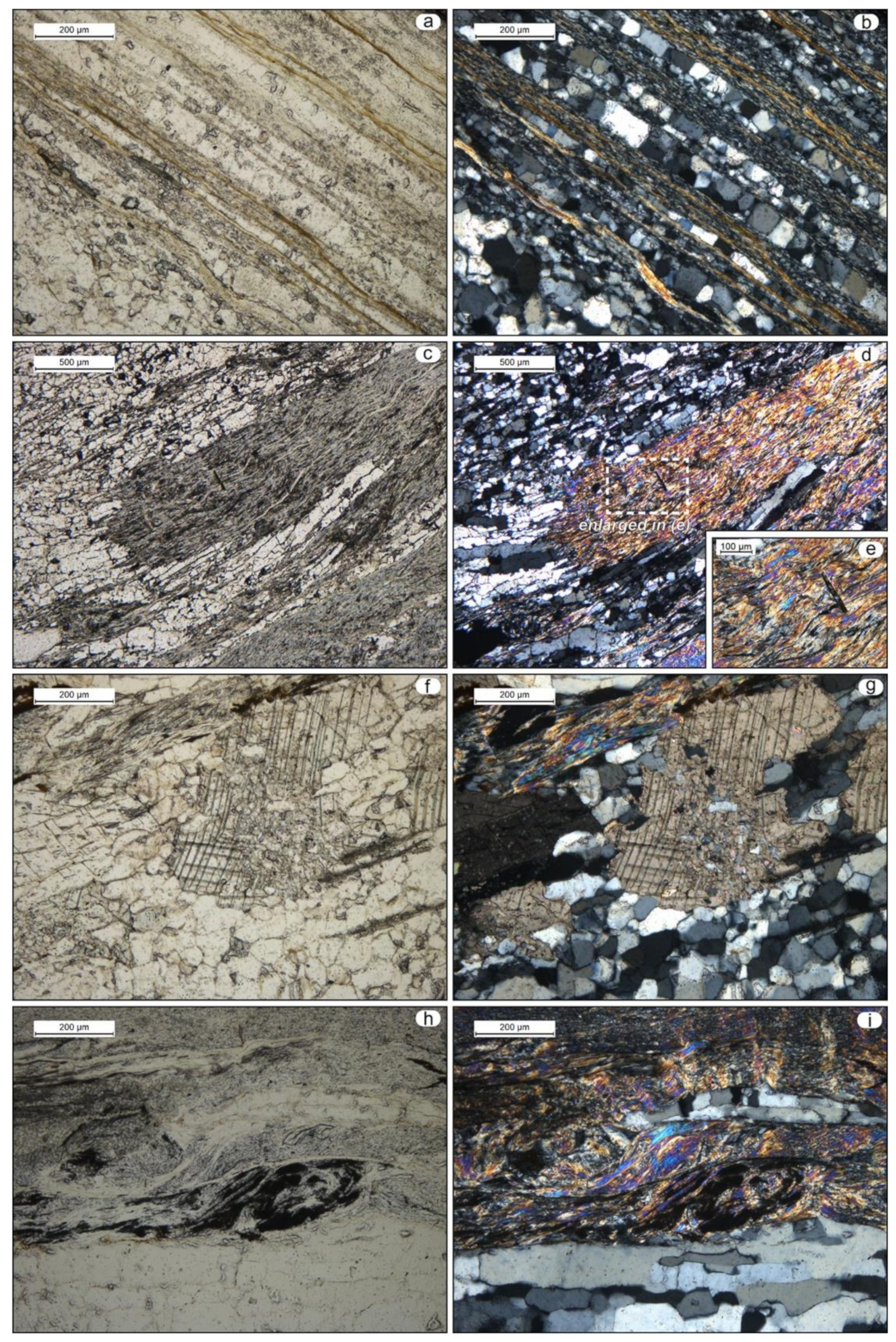

| Sample | Locality | Quote | Latitude | Longitude | Lithology | Analysis | Content |
|---|---|---|---|---|---|---|---|
| RIS 1 | Risanguigno Creek | 304 m a.s.l. | 43°8′3.85″ N | 11°11′38.13″ E | Black phyllite | Palynology | productive |
| RIS 2 | Risanguigno Creek | 304 m a.s.l. | 43°8′4.03″ N | 11°11′37.84″ E | Fine metasandstone | Palynology | barren |
| RIS 3 | Risanguigno Creek | 304 m a.s.l. | 43°8′4.34″ N | 11°11′33.84″ E | Black phyllite | Palynology | productive |
| RIS 4 | Risanguigno Creek | 304 m a.s.l. | 43°8′4.43″ N | 11°11′33.74″ E | Black phyllite | Palynology | productive |
| RIS 5 | Risanguigno Creek | 304 m a.s.l. | 43°8′8.01″ N | 11°11′32.15″ E | Black phyllite and lidyte | Palynology | productive |
| RIS 6 | Risanguigno Creek | 304 m a.s.l. | 43°8′7.95″ N | 11°11′32.12″ E | Black phyllite and lidyte | Palynology | productive |
| RIS 7 | Risanguigno Creek | 304 m a.s.l. | 43°8′7.98″ N | 11°11′32.11″ E | Black phyllite | Palynology | productive |
| RIS 11 | Risanguigno Creek | 304 m a.s.l. | 43°8′3.77″ N | 11°11′40.46″ E | Black phyllite | Palynology | barren |
| RIS 12 | Risanguigno Creek | 304 m a.s.l. | 43°8′4.72″ N | 11°11′34.02″ E | Dolostone | Palynology | barren |
| RIS 13 | Risanguigno Creek | 304 m a.s.l. | 43°8′7.76″ N | 11°11′31.90″ E | Dolostone | Palynology | barren |
| RIS 14 | Risanguigno Creek | 324 m a.s.l. | 43°7′46.76″ N | 11°11′43.98″ E | Black phyllite | Palynology | barren |
| RIS 15 | Risanguigno Creek | 324 m a.s.l. | 43°7′47.91″ N | 11°11′43.53″ E | Black phyllite | Palynology | productive |
| RIS 16 | Risanguigno Creek | 324 m a.s.l. | 43°7′47.95″ N | 11°11′43.44″ E | Black phyllite | Palynology | productive |
| RIS 17 | Farma River | 265 m a.s.l. | 43°5′15.41″ N | 11°11′23.57″ E | Metasiltstone | Palynology | productive |
| RIS 18 | Farma River | 265 m a.s.l. | 43°5′15.32″ N | 11°11′24.59″ E | Black phyllite | Palynology | productive |
| RIS 19 | Farma River | 270 m a.s.l. | 43°5′20.19″ N | 11°11′13.15″ E | Black phyllite | Palynology | barren |
| RIS 20 | Farma River | 270 m a.s.l. | 43°5′20.13″ N | 11°11′13.22″ E | Metacarbonate | Palynology | barren |
| RIS 21 | Farma River | 270 m a.s.l. | 43°5′20.10″ N | 11°11′13.28″ E | Metacarbonate | Palynology/Conodonts | barren |
| RIS 22 | Risanguigno Creek | 304 m a.s.l. | 43°8′4.22″ N | 11°11′33.97″ E | Dolostone | Palynology/Conodonts | barren |
| RIS 23 | Risanguigno Creek | 304 m a.s.l. | 43°8′4.28″ N | 11°11′33.79″ E | Dolostone | Palynology/Conodonts | barren |
| RIS 24 | Risanguigno Creek | 304 m a.s.l. | 43°8′4.18″ N | 11°11′35.98″ E | Dolostone | Palynology/Conodonts | barren |
Publisher’s Note: MDPI stays neutral with regard to jurisdictional claims in published maps and institutional affiliations. |
© 2021 by the authors. Licensee MDPI, Basel, Switzerland. This article is an open access article distributed under the terms and conditions of the Creative Commons Attribution (CC BY) license (http://creativecommons.org/licenses/by/4.0/).
Share and Cite
Capezzuoli, E.; Spina, A.; Brogi, A.; Liotta, D.; Bagnoli, G.; Zucchi, M.; Molli, G.; Regoli, R. Reconsidering the Variscan Basement of Southern Tuscany (Inner Northern Apennines). Geosciences 2021, 11, 84. https://doi.org/10.3390/geosciences11020084
Capezzuoli E, Spina A, Brogi A, Liotta D, Bagnoli G, Zucchi M, Molli G, Regoli R. Reconsidering the Variscan Basement of Southern Tuscany (Inner Northern Apennines). Geosciences. 2021; 11(2):84. https://doi.org/10.3390/geosciences11020084
Chicago/Turabian StyleCapezzuoli, Enrico, Amalia Spina, Andrea Brogi, Domenico Liotta, Gabriella Bagnoli, Martina Zucchi, Giancarlo Molli, and Renzo Regoli. 2021. "Reconsidering the Variscan Basement of Southern Tuscany (Inner Northern Apennines)" Geosciences 11, no. 2: 84. https://doi.org/10.3390/geosciences11020084
APA StyleCapezzuoli, E., Spina, A., Brogi, A., Liotta, D., Bagnoli, G., Zucchi, M., Molli, G., & Regoli, R. (2021). Reconsidering the Variscan Basement of Southern Tuscany (Inner Northern Apennines). Geosciences, 11(2), 84. https://doi.org/10.3390/geosciences11020084









